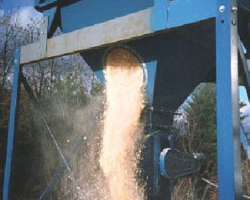Reducing Bridging in Dust Collector Hoppers
Elimination of hopper bridging in a dust collector prevents compromising collector performance & eliminates potential maintenance headaches.
Hopper Bridging Can Impact Dust Collector Performance

While discussions on dust collector sizing and filter efficiency in equipment selection are common, very little literature tends to discuss the need for collected materials to flow freely from the hopper to a final drum, bin or sack. And, yet, the elimination of hopper bridging in a dust collector means the elimination of a potential maintenance headache.
Baghouse and cartridge collectors utilize hoppers to direct collected dust to storage containers or dust transport systems. The dust collector hoppers are not intended to store the collected product, so when material is not discharging, the situation can end up compromising dust collector performance in addition to being a maintenance headache.
Variables Leading to Hopper Bridging
There are many variables that can lead to dust collector hopper bridging – that pesky phenomenon where dust gathers where it is not intended to and inadvertently blocks discharge pathways. Ultimately, bridging traps dust in the hopper and can raise the pressure drop in the dust collector to unacceptable levels because dust is not leaving the collector as intended. This paper will address some of the more common causes of hopper bridging and provide suggestions on how to reduce the risk. It will prepare you to discuss the topic with your dust collector supplier in the beginning phases of your project when it is most beneficial.
The following four variables are common contributors to dust collector hopper bridging:
- Dust characteristics
- Hopper design
- Rotary airlock valve maintenance and size
- Condensation/moisture
Dust Characteristics & Hopper Design
Even fine, dry dusts may have characteristics that make it more difficult to handle within the confines of a dust collector hopper. Some dusts agglomerate while others have high friction on the hopper sides that may keep the dust from flowing smoothly down to the discharge opening.
Example
Woodworking dusts are an excellent example of highly fibrous dusts with a tendency for its fibers to cling to one another. When a hopper outlet is relatively small in size, the fibrous wood dust fibers may be able to bind together and span, or bridge, the opening. Once the opening has been bridged, dust no longer exits, and the hopper begins filling with dust. In extreme situations, the dust build-up may extend up into the dust collector housing before the situation is realized.
Dust Characteristics Can Indicate Necessary Design to Reduce Bridging
Bridging is often problematic because the behavior may not appear until after a dust collector has been installed and is operating. Solutions at this late point can become more expensive. The review of dust characteristics at the beginning of a project may allow for early design choices that reduce the risk of bridging.
Dust characteristics may suggest design features to reduce the risk of bridging. Examples might include: enlarging the discharge opening, replacing sharp corners in the hopper with corners having a larger radius, or even using taller/steeper hoppers to reduce dust retention.
Temporary Hopper Dust Storage During Surges
Keep in mind that dust collector hoppers are not intended for dust storage, however, that doesn’t mean they won’t encounter surges in dust from a process upset or even intentional off-line cleaning. These surges in dust will require the dust collector hopper to serve as temporary dust storage. These temporary situations may involve substantial levels of dust entering the collector hopper, and these materials must quickly and effectively discharge from the hopper, or overall dust collector performance can be compromised.
The use of steeper hopper walls can reduce the risk of bridging by limiting how much dust can build up on the side walls of the hopper. All dusts have an angle of repose representing the maximum angle relative to horizontal at which the dust will flow. Knowing this value can help ensure hopper valley angles/slopes are designed steep enough for the dust to flow freely towards the outlet.
Even fine dry dusts can still develop a bridge at a hopper outlet if they can bind together across the hopper outlet opening. It is important to ensure that the discharge opening is large enough and the hopper valley angles are steep enough to create the necessary pressure/stress to avoid the development of a bridge.
This becomes more important when a rotary airlock valve is attached on the hopper discharge. The presence of a rotary airlock valve limits the discharge rate from the hopper, and any surge of dust load may build-up within the hopper for brief durations as it is being discharged. The time and depth of the dust can sometimes allow a bridge to develop as the rotary airlock valve turns.
Don’t just blindly accept standard hoppers supplied with a dust collector. Stop and consider the dust characteristics, and don’t be afraid to request design changes and options. They are much easier to include at the beginning of a project.
Rotary Airlock Valve Size and Maintenance

The main function of a rotary airlock valve is to provide an air seal at the discharge opening of the dust collector hopper. Rotary airlock valves are often installed between the hopper discharge and a conveyor or discharge bin. While the rotary airlock valve may not seem important in overall dust collector performance, it can cause a lot of problems if it is not sized and/or maintained correctly.
Most dust collectors operate under negative pressure, which means worn rotary airlock valve blades can result in air leakage into the discharge opening of the collector hopper. Regardless of whether the collector is located indoors or outdoors, this air leakage may result in bridging by a couple of mechanisms. The air leakage may introduce moisture from outside the dust collector into the hopper. The result can take typically dry dust and allow it to become sticky, or it can start caking together. Even if the dust stays dry, the air leakage may not allow collected dust in the hopper to flow freely into the rotary airlock valve. This air leakage then results in material build-up in the hopper, increasing the risks of dust re-entrainment, higher pressure drop, and/or shorter filter life. The valve body and rotor blades on a rotary airlock valve need to be inspected for wear on a regular basis with a schedule for replacement determined.
Sizing Rotary Valves to Handle Dust Discharge Surges
Under normal circumstances, sizing a rotary airlock valve is relatively straight forward; its capacity is selected to ensure it is capable of handling a continuous nominal dust discharge rate. Under-sizing a rotary airlock valve generally happens by accident because the designer forgets to consider the larger amounts of dust that may come to the hopper as a result of process upset conditions, or as the result of downtime cleaning. The designer may even overlook the fact that collected dust often falls into the hopper immediately after the exhaust fan has been shut down.
In the case of dust falling after the fan is shut down, the rotary airlock valve will need to be sized to handle larger dust discharge rates. If the designer has the rotary airlock valve shutting down when the fan stops, dust falling into the hopper is trapped until the system starts-up again. This can again result in bridging in addition to other concerns. It is essential to have a time delay for any rotary airlock valve to ensure the hopper is completely empty before it is shut down, whether indoors or outdoors.
Again, many times the standard hopper discharge size is mistakenly regarded as sufficient to handle all dust characteristics. Keep in mind the free flowing nature of dust being collected can completely change when it’s handled in bulk form. Also, don’t forget the impact of the narrowing of hoppers at their discharge outlets.
Potential Bridging due to Safety Screens
Recently, rotary airlock valve manufacturers have begun shipping screens on the discharge side of the rotary airlock valve to prevent personnel from reaching up into the valve. Unfortunately, these screens sometimes inhibit the free flow of the dust from the discharge of the rotary airlock valve and, depending on the characteristics of the dust, users may need to be aware of the screens and the potential bridging problems they may cause.
Condensation & Moisture
Some dust exhibit a characteristic known as hygroscopicity. This characteristic can be described as the tendency of dust to take up and retain moisture. This behavior can be a source of concern if moisture is present in the hopper. As hygroscopic dust falls into the hopper, the final flow characteristic may change if moisture is present, causing many of the same bridging problems previously described.
Besides leakage allowing moisture to enter a hopper discharge opening, there may also be an opportunity for moisture to condense on the inside surface of a dust collector hopper that has been shut down for a period of time. This occurs in many regions of the country when collectors are located outdoors, but may also occur with collector in unconditioned plants.
As temperatures rise and fall, warm process air enters the dust collector, and these conditions allow moisture to condense on the inside of non-insulated collector walls. The condensed moisture can react with sensitive dusts, which then tend to stick to the hopper sides. This behavior reduces the free-flowing of dusts and eventually results in bridging. The same is true for dust that is allowed to remain in the hopper if a rotary airlock valve is stopped at the same time as the exhaust fan is shut down. Condensation can change dust flow characteristics.
When dust collectors are located where condensation is a concern, such as outdoors in colder climates, the exhaust fan should start circulating air though the collector to warm the dust collector housing and hopper before dust is drawn into the collector. The exhaust fan should also run for a short period of time after dust has stopped entering the dust collector to ensure the surfaces of the collector stay warm until all dust has been evacuated from the collector. These steps will help avoid the condensation that occurs from a cold start up or shut down. Insulation may also be a consideration if this warm/cold condition is apparent in the dust collector location.
Additional Steps to Avoid Hopper Bridging
Other actions that can help reduce the risk of hopper bridging include items such as:
- Zero speed switches, which monitor a rotary airlock valve to ensure the rotor is turning and
- Hopper level indicators, which are designed to provide an early indication of any build-up in the hopper. These options often have relatively low cost – especially considering the problems they can head off.
Knowing the common causes of bridging is key to incorporating ways to reduce the troublesome phenomenon. This knowledge will enable you to discuss bridging concerns early in your conversations with dust collection representatives. A sticky or moist dust may require steeper sided hoppers, a factory applied non-stick internal hopper coating, or both. Dry, fine bulk type dust, agglomerative dust, and hygroscopic dust may require larger than standard hopper discharge openings, and rotary airlock valves may need to be larger in size. Even considerations such as external insulation may need to be discussed where hopper condensation could occur.
Summary
Bridging concerns rarely relate to the sizing of the dust collector or its filtration efficiency, but the phenomenon does result in lost production. The good news is hopper bridging can be reduced in many instances with early decisions on dust collector configuration and hopper discharge device selection.

AST Canada has been helping clients find solutions for their unique Dust, Mist & Fume Collection needs for more than 40 years.
We can help you too.
